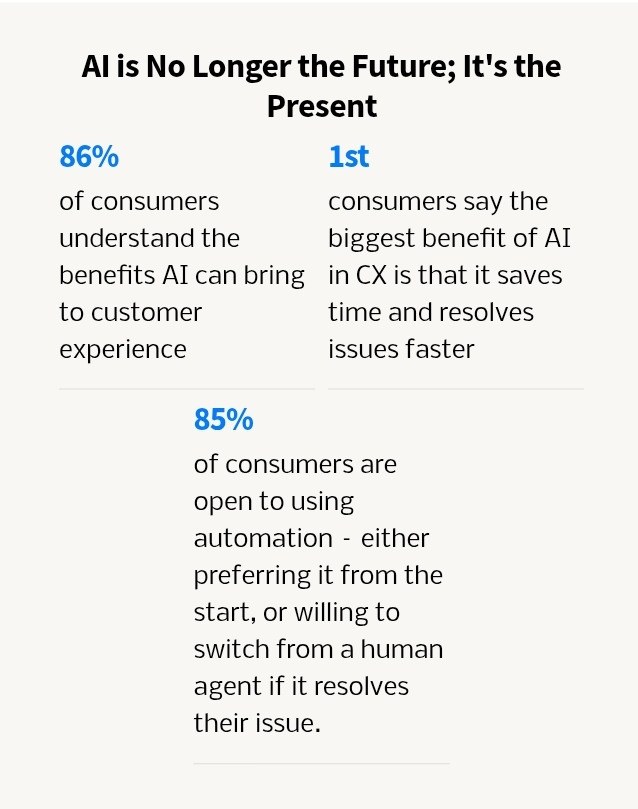AI-Powered CX: The 2025 Reality Check
Remember when chatbots felt like talking to a wall? Well, those days are officially over. According to Verint’s latest State of Customer Experience 2025 report, artificial intelligence has finally crossed the threshold from annoying gimmick to genuine game-changer. A business can’t excel without AI-Powered CX.
The Numbers Don’t Lie
First, let’s talk about the elephant in the room. Meanwhile, 86% of consumers now recognize AI’s benefits in customer service. Moreover, this isn’t just polite acceptance – it’s active demand for smarter, faster solutions.
Interestingly, the younger crowd leads this charge. Specifically, 98% of 18-to-34-year-olds embrace AI-powered customer interactions. Consequently, brands targeting younger demographics must prioritize AI integration or risk becoming irrelevant.
Furthermore, these consumers aren’t just tolerating AI – they’re expecting it. In fact, they want their problems solved efficiently, regardless of whether humans or machines handle the resolution.
Efficiency Trumps Everything
Here’s where things get fascinating. Surprisingly, 56% of consumers prioritize quick information access over empathy. Additionally, this represents nearly four times more preference than traditional human-centered approaches.
Therefore, the old “customer service with a smile” philosophy needs updating. Instead, today’s consumers value speed, accuracy, and results above warm conversations. Subsequently, brands must redesign their CX strategies around efficiency metrics rather than emotional connections.
Nevertheless, this doesn’t mean abandoning human touch entirely. Rather, it means deploying AI for routine tasks while reserving human agents for complex, emotionally charged situations.
Digital Channels Dominate
Meanwhile, another significant shift emerges in channel preferences. Specifically, 73% of consumers now prefer digital channels over traditional phone support. Moreover, among younger demographics, this preference skyrockets to 89%.
Consequently, brands still relying heavily on phone-based support face an uphill battle. Furthermore, digital-first strategies aren’t just trendy – they’re essential for survival. Therefore, companies must invest in robust digital infrastructure immediately.
Additionally, this preference extends beyond simple convenience. Indeed, digital channels offer better tracking, faster resolution, and more personalized experiences than traditional alternatives.
The High Stakes of Poor Experience
Now, let’s examine the consequences of getting CX wrong. Alarmingly, 78% of consumers will consider switching brands after just one poor interaction. Furthermore, this represents an increase from 67% in 2024.
Therefore, the margin for error continues shrinking. Additionally, brands can no longer rely on customer loyalty to overcome service failures. Instead, every interaction becomes a make-or-break moment for customer retention.
Moreover, this trend reflects consumers’ growing awareness of available alternatives. Consequently, switching costs have decreased while service expectations have risen dramatically.
The Revenue Impact of Excellence
Conversely, brands delivering exceptional CX reap substantial rewards. Specifically, 86% of customers return to make additional purchases after amazing experiences. Furthermore, 81% actively recommend these brands to others.
Therefore, investing in superior CX becomes a revenue multiplier rather than a cost center. Additionally, satisfied customers transform into brand ambassadors, reducing acquisition costs while increasing lifetime value.
Moreover, this word-of-mouth marketing proves more effective than traditional advertising. Consequently, exceptional CX becomes a competitive differentiator that compounds over time.
The AI Implementation Reality
However, implementing AI-powered CX isn’t just about deploying technology. Instead, it requires strategic thinking about customer journeys and pain points. Moreover, successful implementations focus on solving specific problems rather than showcasing technological capabilities.
Additionally, brands must ensure their AI solutions actually improve customer outcomes. Otherwise, consumers quickly recognize and reject poorly designed automation attempts.
Furthermore, effective AI implementation requires continuous learning and optimization. Therefore, brands must invest in ongoing refinement rather than one-time deployments.
Strategic Implications for CX Leaders
Given these findings, CX leaders must fundamentally rethink their strategies. First, they must prioritize AI integration across all customer touchpoints. Additionally, they must redesign metrics around efficiency rather than traditional satisfaction scores.
Moreover, investment priorities should shift toward digital channel optimization. Consequently, phone support should become a specialized service rather than the primary interaction method.
Furthermore, brands must develop comprehensive AI governance frameworks. Therefore, they can ensure consistent, high-quality experiences across all automated interactions.

The Measurement Challenge
Nevertheless, measuring AI-powered CX success requires new approaches. Traditional metrics like first-call resolution become less relevant when customers prefer self-service options. Instead, brands must focus on outcome-based measurements.
Additionally, customer effort scores gain importance as efficiency becomes paramount. Moreover, brands must track resolution speed alongside accuracy metrics to ensure balanced optimization.
Furthermore, predictive analytics become essential for identifying potential issues before they impact customer satisfaction. Therefore, proactive problem-solving replaces reactive damage control.
Looking Forward
Ultimately, the Verint study reveals a fundamental shift in customer expectations. Consumers no longer view AI as experimental technology – they consider it essential infrastructure. Moreover, brands failing to deliver AI-powered efficiency risk losing customers to more innovative competitors.
Therefore, the question isn’t whether to implement AI-powered CX, but how quickly and effectively brands can execute this transformation. Additionally, first-movers in this space will capture disproportionate advantages as consumer expectations continue evolving.
Furthermore, this trend will likely accelerate as younger, AI-native consumers represent larger market segments. Consequently, brands must act decisively to remain competitive in this rapidly changing landscape.
The era of AI-powered customer experience has arrived. Smart brands will embrace this reality and transform their operations accordingly. Others will struggle to keep pace with increasingly demanding consumer expectations.

